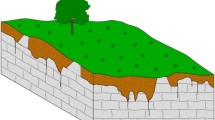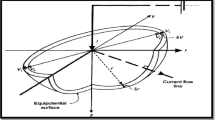Abstract
Electrical resistivity tomography (ERT) data were collected in a heavily Karstic area in southwest MO. The interpretation of the study has highlighted that the data of electrical resistivity tomography was abrupt by the multichannel analysis of surface wave data and the restricted drilling control. The study’s primary goal was to ascertain whether variations in shallow rock and soil were associated with the terrain’s topography. The first objective of this research is the establishment whether the topography of the rock’s surface correlates with the paths used for surface drainage or not. The second objective is the exploration of the zones that mainly have low resistivity, particularly in karst terrain, and to analyse if these zones are somehow connected with sinkholes and solution-widened joints. The third objective is to comprehend and conduct an extensive assessment of soil and rock structure with the help of 2D and 3D mapping of the noninvasive ERT, and the fourth objective is to assess the geological and hydrological conditions and to analyse the flow patterns of groundwater underground and the surface drainage paths. The analysis of data has primarily shown that, except for soil near interpreted prominent joint sets, the resistivity values of shallow rock beneath and close to natural and man-made surfaces are typically lower than those of soil and rock elsewhere. It was determined that because moisture penetrates the subsurface in greater quantities along superficial flow trails than elsewhere in the research region, rock and soil resistivity beneath manmade and natural drainage channels is frequently abnormally low.










Similar content being viewed by others
References
Alfuqara DAA (2017) 2-D and 3-D mapping of soil and rock structure in karst terrain of southwestern Missouri using the non-invasive electrical resistivity tomography method (ERT), PhDT
Anderson NL, Apel DB, et al (2006) Assessment of karst activity at highway construction sites using the electrical resistivity method (Greene and Jefferson Counties, Missouri)
Bou-Hamdan K (2020) “An experimental approach that scans the surface area using ultrasonic waves to generate a two-dimensional image, 2020 7th International Conference on Electrical and Electronics Engineering (ICEEE), 2020, pp. 264–267, https://doi.org/10.1109/ICEEE49618.2020.9102557
Bou-Hamdan KF (2021) Design and implementation of an ultrasonic scanner setup that is controlled using MATLAB and a microcontroller. Adv Sci Technol Eng Syst J 6(2):85–92
Bou-Hamdan K, Abbas A (2021) Utilizing ultrasonic waves in the investigation of contact stresses, areas, and embedment of spheres in manufactured materials replicating proppants and brittle rocks. Arab J Sci Eng 47 https://doi.org/10.1007/s13369-021-06409-6
Bou-Hamdan KF, Abbas AH (2022) Utilizing ultrasonic waves in the investigation of contact stresses, areas, and embedment of spheres in manufactured materials replicating proppants and brittle rocks. Arab J Sci Eng 47(9):11635–11650
Chukwunonso JO (2016) “Geophysical imaging of karst features in Missouri
Coots (2013) Greene County Comprehensive Plan: Greene County planning and zoning [Online] Available at: http://www.greenecountymo.org/web/Public_Information/files/Comp.pdf. Accessed 20 Sept 2022
Coşkun N (2012) The effectiveness of electrical resistivity imaging in sinkhole investigations. Int J Phys Sci 7(15)
Dahlin T, Loke MH (2018) Underwater ERT surveying in water with resistivity layering with example of application to site investigation for a rock tunnel in central Stockholm. Near Surf Geophys 16(3):230–237
Daibo M (2017) Toroidal vector-potential transformer. In 2017 Eleventh International Conference on Sensing Technology (ICST). IEEE, pp. 1–4
Derek F, Paul W (2007) Karst hydrogeology and geomorphology. John Wiley & Sons, Ltd
Dimech A, Cheng L, Chouteau M, Chambers J, Uhlemann S, Wilkinson P, ... Isabelle A (2022) A review on applications of time-lapse electrical resistivity tomography over the last 30 years: perspectives for mining waste monitoring. Surv Geophys 1–61
Ducut JD, Alipio M, Go PJ, Concepcion R II, Vicerra RR, Bandala A, Dadios E (2022) A review of electrical resistivity tomography applications in underground imaging and object detection. Displays 102208
Elmo D, Mitelman A, Yang B (2022) Examining rock engineering knowledge through a philosophical lens. Geosciences 12(4):174
Gou S, Miller G (2014) A groundwater–soil–plant–atmosphere continuum approach for modelling water stress, uptake, and hydraulic redistribution in phreatophytic vegetation. Ecohydrology 7(3):1029–1041
Hasan M, Shang Y (2022) Hard-rock investigation using a non-invasive geophysical approach. J Appl Geophys 206:104808. https://doi.org/10.1016/j.jappgeo.2022.104808
Hiltunen DR, Roth MJ (2004) Investigation of bridge foundation sites in karst terrane via multi-electrode electrical resistivity. Geotech Geophys Site Charact 483–489
Ismail A, Anderson N (2012) 2-D and 3-D resistivity imaging of karst sites in Missouri, USA. Environ Eng Geosci 18(3):281–293
Jon Robinson, Anderson NL (2008) Assessment of karst activity at Clarksville study site, unpublished report for SCI Engineering
Junaid M, Abdullah RA, Saa’ri R, Alel MNA (2022) An expeditious approach for slope stability assessment using integrated 2D electrical resistivity tomography and unmanned aerial vehicle survey. J Appl Geophys 205:104778
Leuschen MA, Officer SEP, Leuschen DM Re (2018) Technical work plan and schedule upland landfill upland excavating, Campbell River, British Columbia
Middendorf MA, Thomson KC, Eason GL, Summer HS (1987) Bedrock geologic map of the Springfield 1 degree * 2 degrees quadrangle, Missouri: US Geological Survey, Miscellaneous Field Studies Map MF-1830-D
Mouici R, Baali F, Hadji R, Boubaya D, Audra P, Fehdi CÉ, ... Arfib B (2017) Geophysical, geotechnical, and speleologic assessment for karst-sinkhole collapse genesis in Cheria Plateau (NE Algeria). Min Sci 24: 59–71
Vandike JE (1993) Groundwater level data for Missouri: water year 1991–1992. Missouri Department of Natural Resources. Division of Geology and Land Survey. Water Resource Report No.42. Rolla, Missouri
Wightman M, Zisman E (2008) The selection and application of geophysical test methods in West Central Florida Karst regions. Sinkholes Eng Environ Impacts Karst 81–90
Xia Y, Zhou H, Zhang C, He S, Gao Y, Wang P (2022) The evaluation of rock brittleness and its application: a review study. Eur J Environ Civ Eng 26(1):239–279
Youssef YM, Gemail KS, Sugita M, AlBarqawy M, Teama MA, Koch M, Saada SA (2021) Natural and anthropogenic coastal environmental hazards: an integrated remote sensing, GIS, and geophysical-based approach. Surv Geophys 42(5):1109–1141
Zhou W, Beck BF, Stephenson JB (1999) Investigation of ground water flow in karst areas using component separation natural potential measurements. J Environ Geol 37:19–25
Zhu C, Yang X, Tao Z, Sun J (2022) Challenges and opportunities in rock mechanics and engineering—an overview. Energies 15(3):807
Funding
The authors greatly acknowledged the Tafila Technical University (TTU) and the Missouri University of Science and Technology (MS&T) for funding this research.
Author information
Authors and Affiliations
Corresponding author
Ethics declarations
Conflict of interest
The authors declare no competing interests.
Additional information
Responsible Editor: Narasimman Sundararajan
Rights and permissions
Springer Nature or its licensor (e.g. a society or other partner) holds exclusive rights to this article under a publishing agreement with the author(s) or other rightsholder(s); author self-archiving of the accepted manuscript version of this article is solely governed by the terms of such publishing agreement and applicable law.
About this article
Cite this article
Alfuqara, D., Anderson, N. Geophysical site assessment of soil and the rock structure in karst terrain using 2D and 3D mapping of noninvasive electrical resistivity tomography—southwestern of MO, USA. Arab J Geosci 16, 103 (2023). https://doi.org/10.1007/s12517-023-11196-5
Received:
Accepted:
Published:
DOI: https://doi.org/10.1007/s12517-023-11196-5




